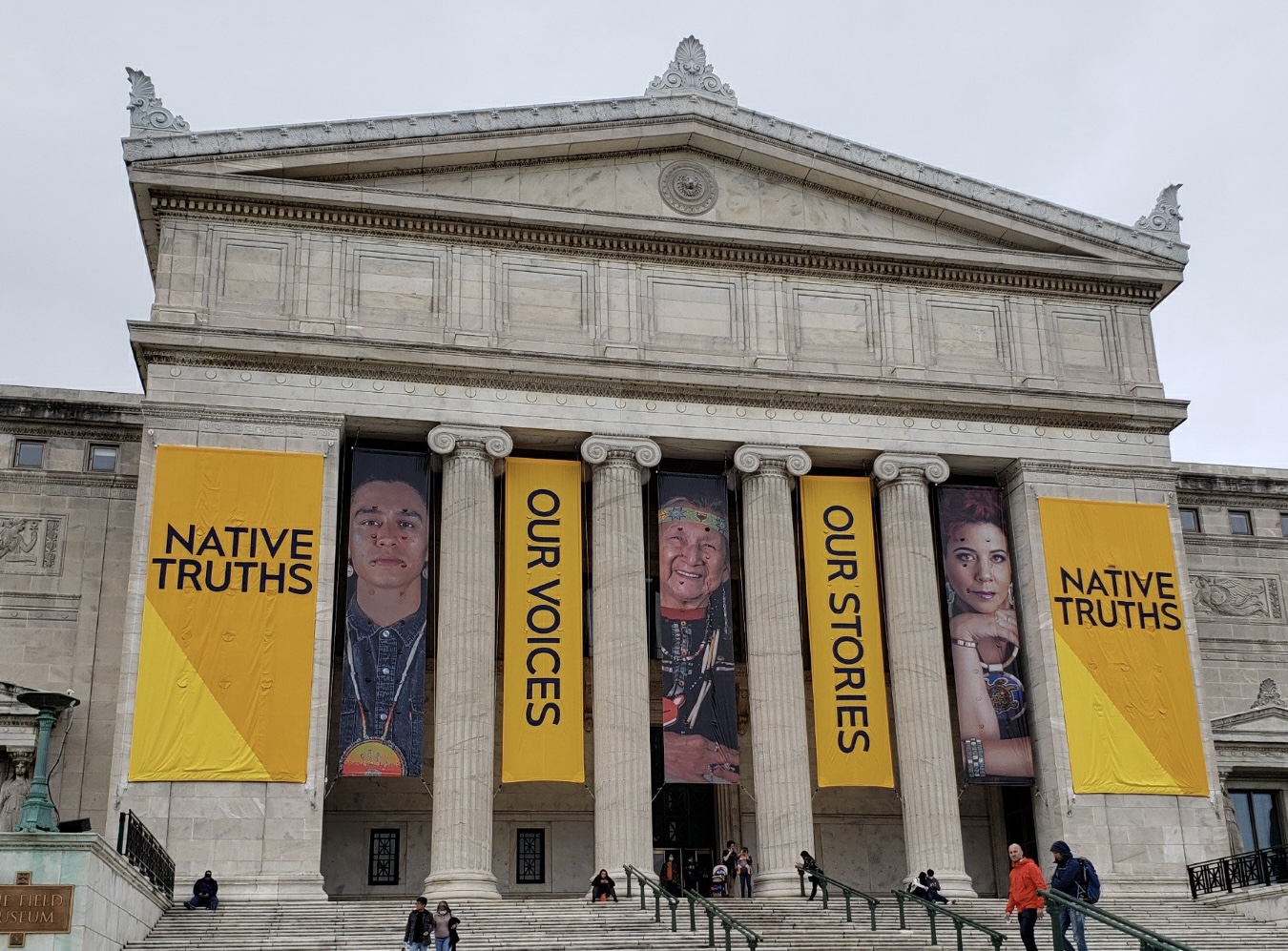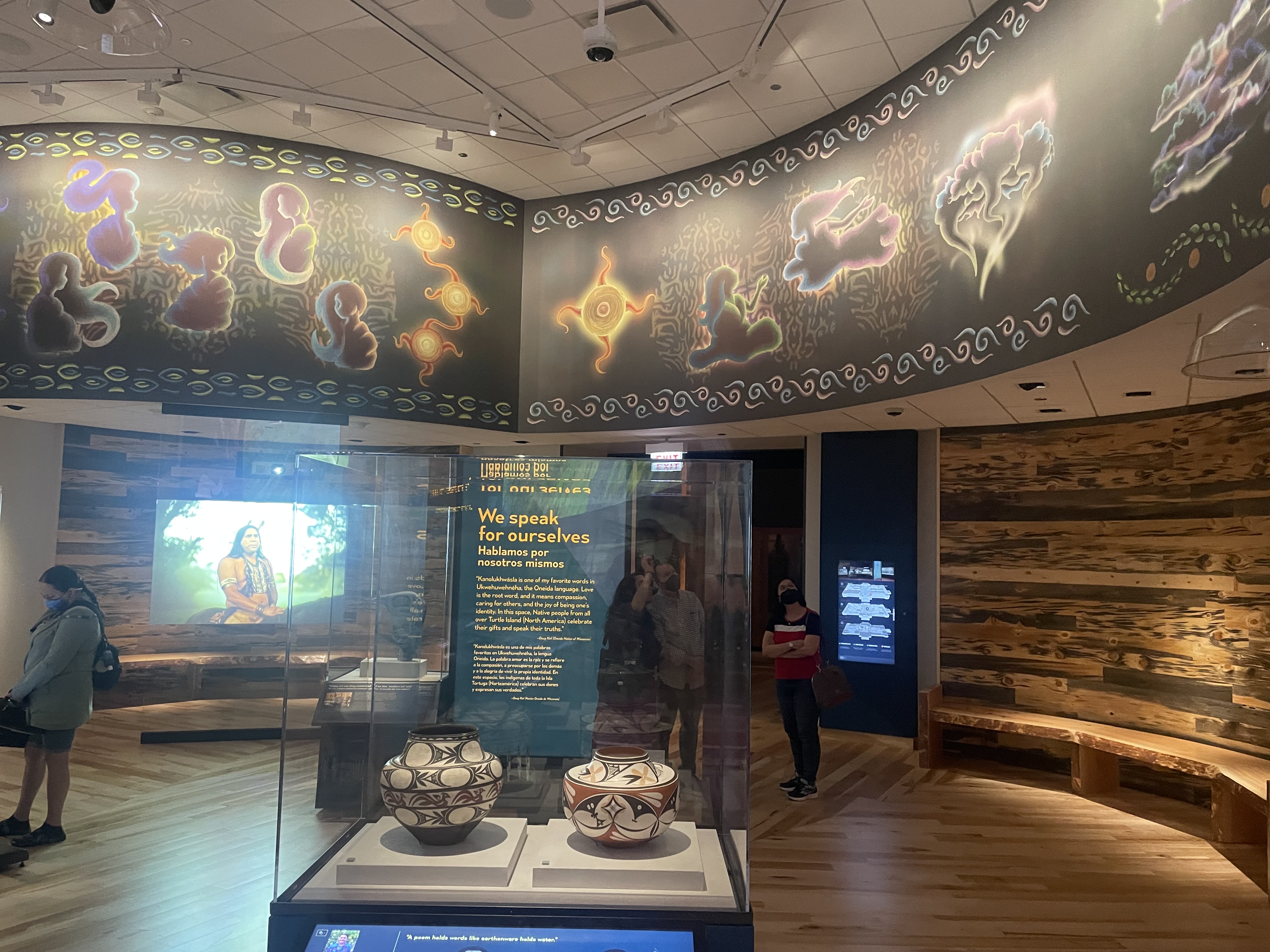
- Details
- By Kelsey Turner
CHICAGO —This Friday, the Chicago Field Museum is opening its new Native Truths: Our Voices, Our Stories exhibition to the public, revealing its first renovation of the museum’s Native North America Hall since its initial installation during the 1950s. The exhibition is centered around five core content permanent sections called “Native Truths” that present essential information about Native experience and culture, along with six rotating story galleries.
The exhibition came together after four and a half years of collaborations between Native elders, community members, artists, educators, scholars, and museum staff. Representing 105 different tribes and displaying an estimated 400 items, it explores current issues like tribal sovereignty and climate change while honoring Native history and culture.
“I’m awestruck,” said Dakota and Diné artist and comedian Dallas Goldtooth as he walked through the exhibition. “I’m so used to these spaces feeling so foreign, because it’s like we’re on display, Native people and cultures are on display. This very much feels like we are in charge of the narrative.” A clip from the FX series Reservation Dogs featuring Goldtooth as the character William Knife-Man plays in a loop inside the hall.
As visitors enter the exhibition, they pass bold, black letters on the wall reading, “You are on Native land.” A recording of a poem written by the Indigenous-futurist artist X sounds throughout the entranceway, read aloud by Chicago-based Potawatomi artist Monica Rickert-Bolter. Further inside the exhibition is an acknowledgement in glowing yellow text: “Museum collecting and exhibition practices have deeply harmed Native communities. This exhibition marks a new beginning.”
In addition to displaying traditional art forms and cultural items, the exhibition also highlights more contemporary mediums like digital art, video, photography, and modern music. The labels for each display are written in the first person, allowing the artists to speak for themselves.
“The old hall just really disconnected Native people as humans from our items, because it was very object-based,” said the museum’s Native Community Engagement Coordinator Debra Yepa-Pappan, a citizen of Jemez Pueblo. “With this [exhibition], you’re actually hearing voices, you’re seeing images of children. It’s bringing us back into the present.”
Previously, the Field Museum’s Native North America Hall included over a thousand cultural items from different tribes with little context regarding the stories behind them. Due to cultural insensitivity and a lack of consultation with tribes when the exhibition first opened in the 1950s, the museum had incorrectly attributed certain items and displayed some pieces that were not meant for public viewing.
For the renovated exhibition, the museum spoke directly with tribes about how best to honor their cultural objects. To appropriately display a sacred stand-up headdress made by a Blackfoot ancestor, for example, museum staff spent three years conversing with Blackfoot women and elders to gain their permission and guidance on the exhibit. The museum invited several of these women to attend the exhibition’s opening ceremony on Saturday.
“In the past, museums often would not even talk to anybody in the community about how they were going to present what are often called ‘artifacts,’” said Rosalyn LaPier, an enrolled Blackfoot tribal member, historian, and collaborator on the stand-up headdress display. “We spent time, as I think everybody did, on making sure that the history that was being shared was appropriate and correct.”
 The exhibit mixes art, videos with narratives. (Photos/Levi Rickert for Native News Online)
The exhibit mixes art, videos with narratives. (Photos/Levi Rickert for Native News Online)
The idea for the renovation began after local artist Chris Pappan, a citizen of the Kaw Nation and husband of Yepa-Pappan, displayed his work in a temporary exhibit within the old Native North America Hall from 2016 to 2019. Pappan inserted contemporary artwork depicting Native cultures into the exhibition, a commentary meant to make viewers confront the museum’s outdated portrayal of Native people.
“There was no information regarding who the people were,” Pappan said of the old exhibition. “I was able to intervene and create work to liven up the space and make more of an impression that we’re a living culture.”
When his exhibit went up, a “light went off” for the museum staff as they recognized the changes that needed to be made to the Native hall, said Alaka Wali, curator emerita of North American Anthropology. The museum then began raising money for a renovated Native American exhibition that would properly honor Indigenous people’s stories.
The museum put together an advisory committee of Native American scholars, museum professionals, artists, and community members from across what is now the United States and Canada to guide the project. The committee helped ensure every component of the exhibition reflects and supports Indigenous communities, right down to the hall’s building materials – Menominee Tribal Enterprises, a sustainable lumber supplier that manufactures products on the Menominee Indian Reservation in Wisconsin, provided maple wood for the flooring, while birch bark wall panels serve to ground visitors within the Great Lakes region.

Yepa-Pappan also successfully advocated for the use of copper, a metal that holds significance for Great Lakes tribes, as a decorative element in the walls. The exhibition designer originally planned to use stainless steel, she said. “It looked nice initially, but at the same time, for me personally as a Native person, it still felt somewhat industrial.” The copper used in the exhibition ranges in color from bronze to blue to red, giving the space a more natural feel.
Yepa-Pappan has been encouraged by the positive feedback Indigenous visitors have given the exhibition, which opened to the Native American community last weekend. “I had always hoped that this exhibition would be for Native people – of course, by Native people, but for Native people also,” she said. “This is Native space. We made this our space.”
Details about the Chicago Field Museum’s opening ceremony of the Native Truths: Our Voices, Our Stories exhibition on Saturday can be found here.
-
 Basket weaver from Riverside, Calif. shows her artistic talents. Basket weaver from Riverside, Calif. shows her artistic talents.
Basket weaver from Riverside, Calif. shows her artistic talents. Basket weaver from Riverside, Calif. shows her artistic talents. -
 Debra Yepa-Peppan (Jemez Pueblo/Korean), Community Engagement Coordinator for the Native Truths project. Debra Yepa-Peppan (Jemez Pueblo/Korean), Community Engagement Coordinator for the Native Truths project.
Debra Yepa-Peppan (Jemez Pueblo/Korean), Community Engagement Coordinator for the Native Truths project. Debra Yepa-Peppan (Jemez Pueblo/Korean), Community Engagement Coordinator for the Native Truths project. -
 Mary Ellenwood Mary Ellenwood
Mary Ellenwood Mary Ellenwood -
 Dallas Goodtooth, resident of the Chicago area, shown in his role on Rez Dogs. Dallas Goodtooth, resident of the Chicago area, shown in his role on Rez Dogs.
Dallas Goodtooth, resident of the Chicago area, shown in his role on Rez Dogs. Dallas Goodtooth, resident of the Chicago area, shown in his role on Rez Dogs. -
 Turtle Island by Monica Rickert-Bolter (Prairie Band Potawatomi Nation). Turtle Island by Monica Rickert-Bolter (Prairie Band Potawatomi Nation).
Turtle Island by Monica Rickert-Bolter (Prairie Band Potawatomi Nation). Turtle Island by Monica Rickert-Bolter (Prairie Band Potawatomi Nation). -
 Land acknowledgement. Land acknowledgement.
Land acknowledgement. Land acknowledgement. -
 Sherman Indian Boarding School shown in a video in Native Truths. Sherman Indian Boarding School shown in a video in Native Truths.
Sherman Indian Boarding School shown in a video in Native Truths. Sherman Indian Boarding School shown in a video in Native Truths. -
 Art by Monica Rickert-Bolter (Prairie Band Potawatomi Nation) Art by Monica Rickert-Bolter (Prairie Band Potawatomi Nation)
Art by Monica Rickert-Bolter (Prairie Band Potawatomi Nation) Art by Monica Rickert-Bolter (Prairie Band Potawatomi Nation) -
 Visual throughout exhibit connect the past to the present. Visual throughout exhibit connect the past to the present.
Visual throughout exhibit connect the past to the present. Visual throughout exhibit connect the past to the present.
https://nativenewsonline.net/arts-entertainment/opening-of-chicago-field-museum-s-native-truths-exhibition-marks-a-new-beginning#sigProIde6543e115d
More Stories Like This
From Dishwasher to Award-Winning Chef: Laguna Pueblo's Josh Aragon Serves Up Albuquerque's Best Green Chile StewRob Reiner's Final Work as Producer Appears to Address MMIP Crisis
Vision Maker Media Honors MacDonald Siblings With 2025 Frank Blythe Award
First Tribally Owned Gallery in Tulsa Debuts ‘Mvskokvlke: Road of Strength’
Zuni Youth Enrichment Project and Partners at Ho’n A:wan Productions Launch 8th Annual Delapna:we Project
Help us defend tribal sovereignty.
At Native News Online, our mission is rooted in telling the stories that strengthen sovereignty and uplift Indigenous voices — not just at year’s end, but every single day.
Because of your generosity last year, we were able to keep our reporters on the ground in tribal communities, at national gatherings and in the halls of Congress — covering the issues that matter most to Indian Country: sovereignty, culture, education, health and economic opportunity.
That support sustained us through a tough year in 2025. Now, as we look to the year ahead, we need your help right now to ensure warrior journalism remains strong — reporting that defends tribal sovereignty, amplifies Native truth, and holds power accountable.
 The stakes couldn't be higher. Your support keeps Native voices heard, Native stories told and Native sovereignty defended.
The stakes couldn't be higher. Your support keeps Native voices heard, Native stories told and Native sovereignty defended.
Stand with Warrior Journalism today.
Levi Rickert (Potawatomi), Editor & Publisher

